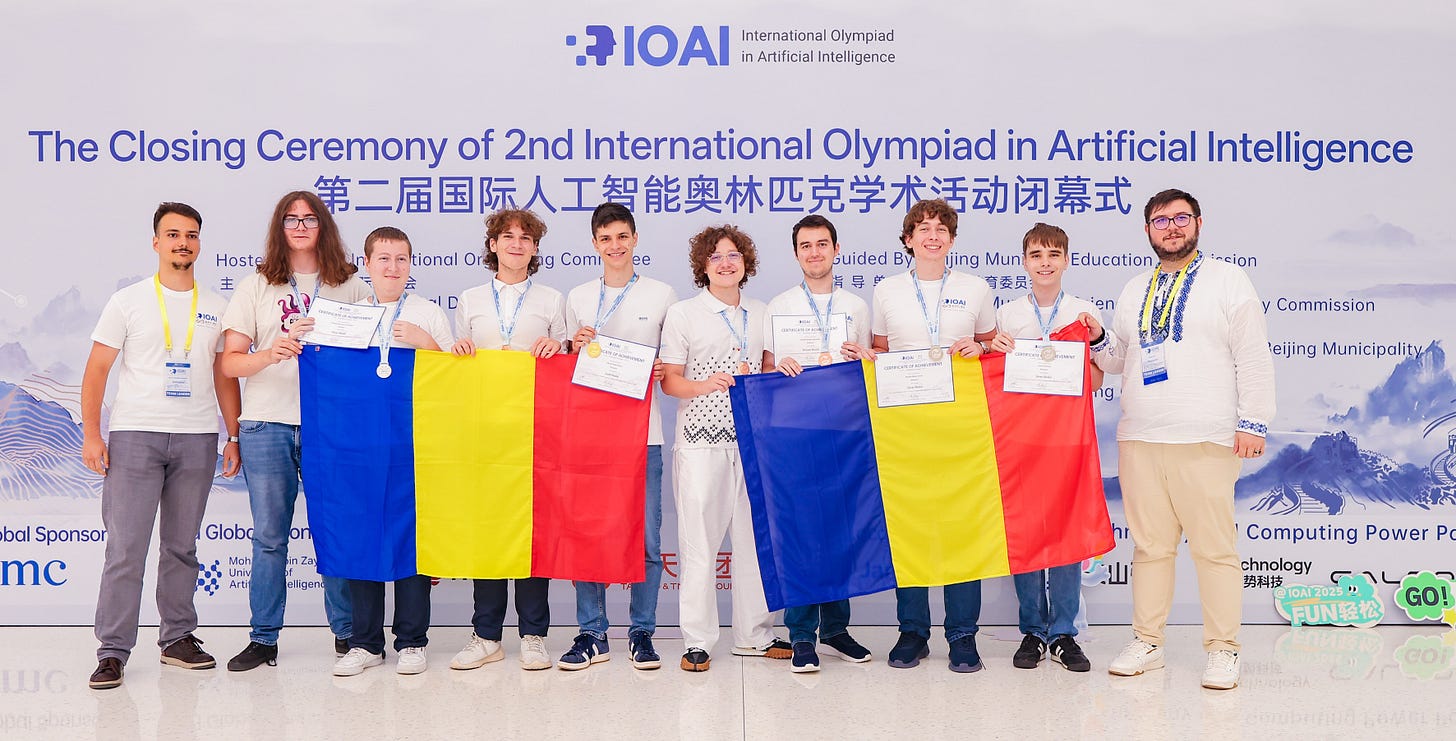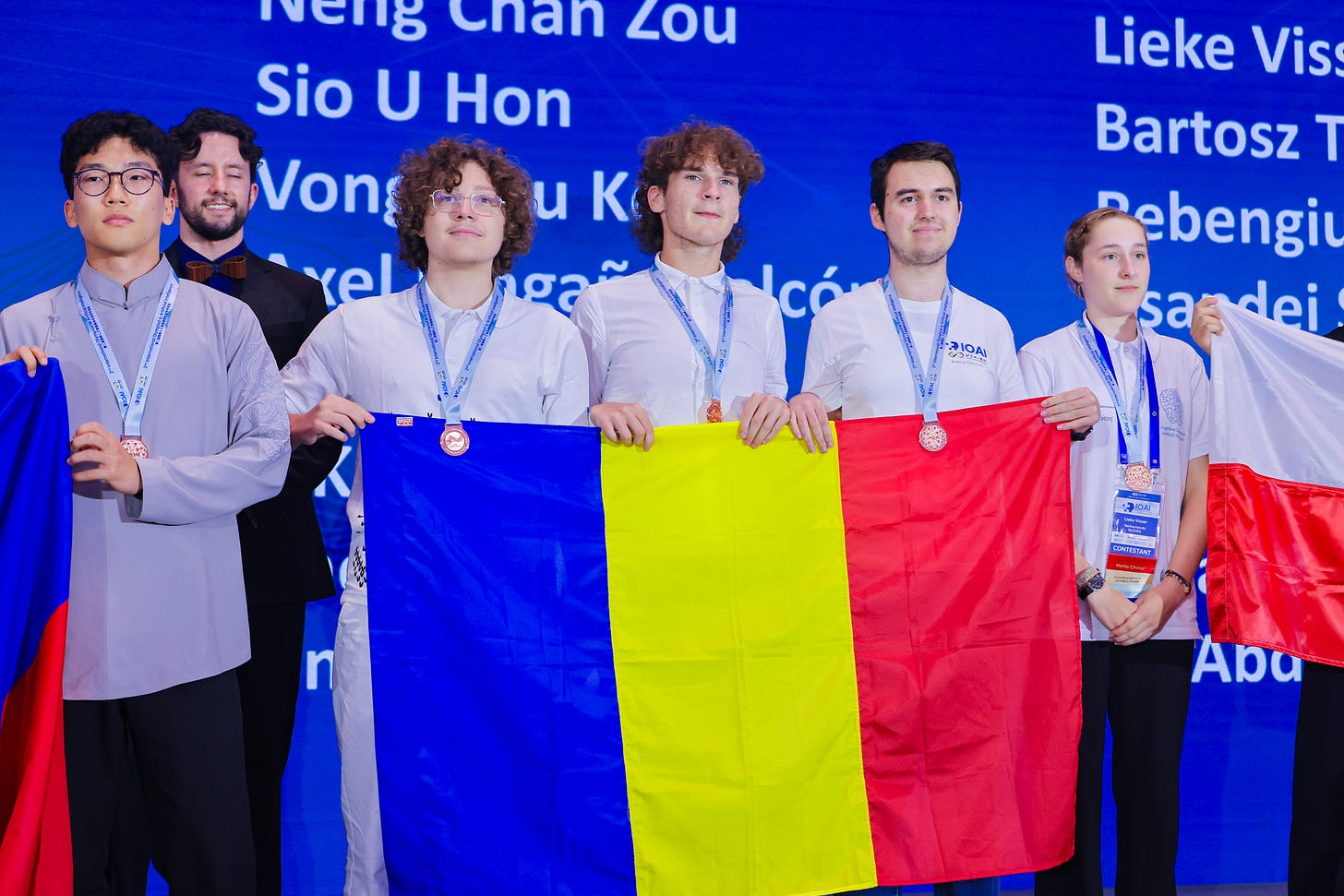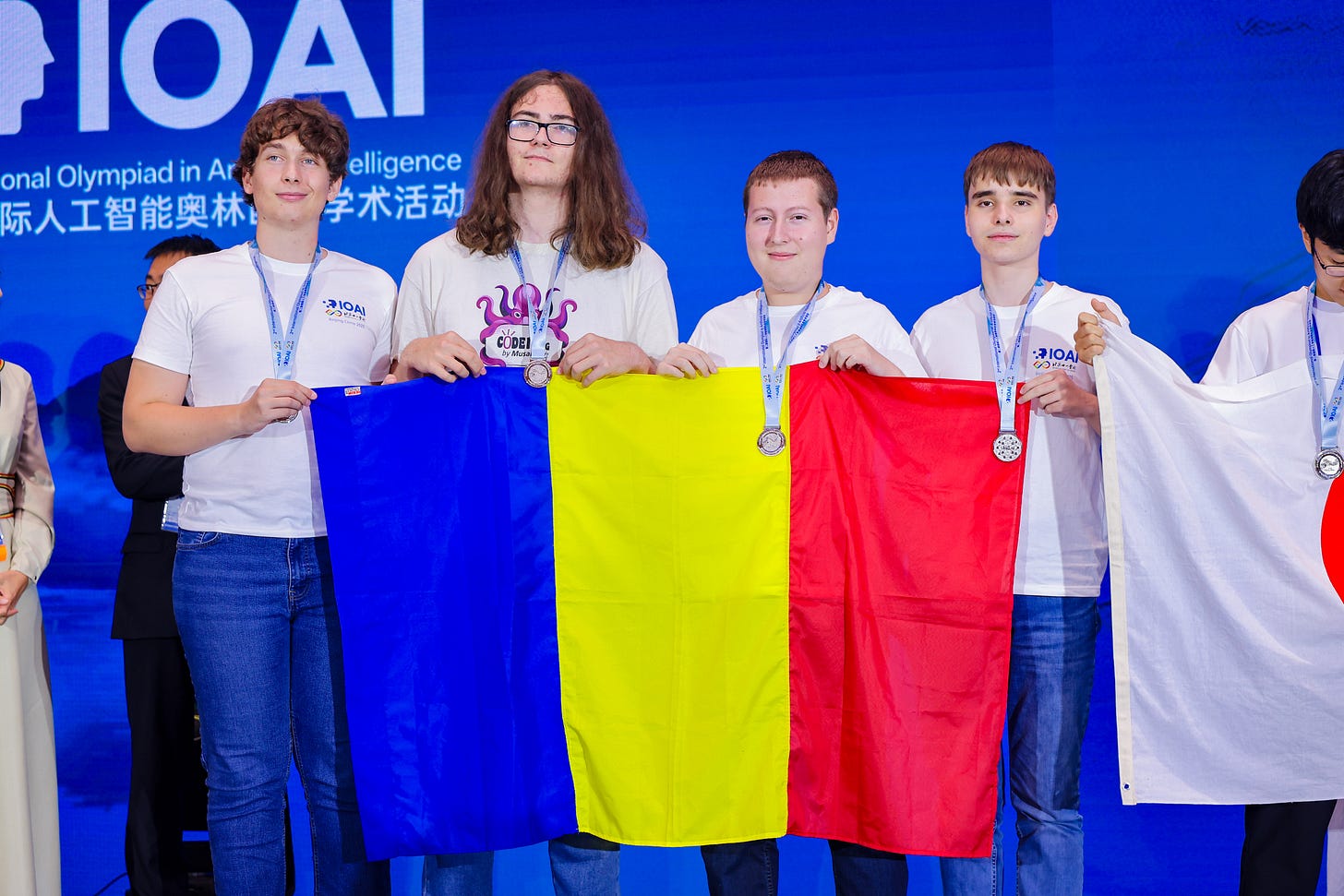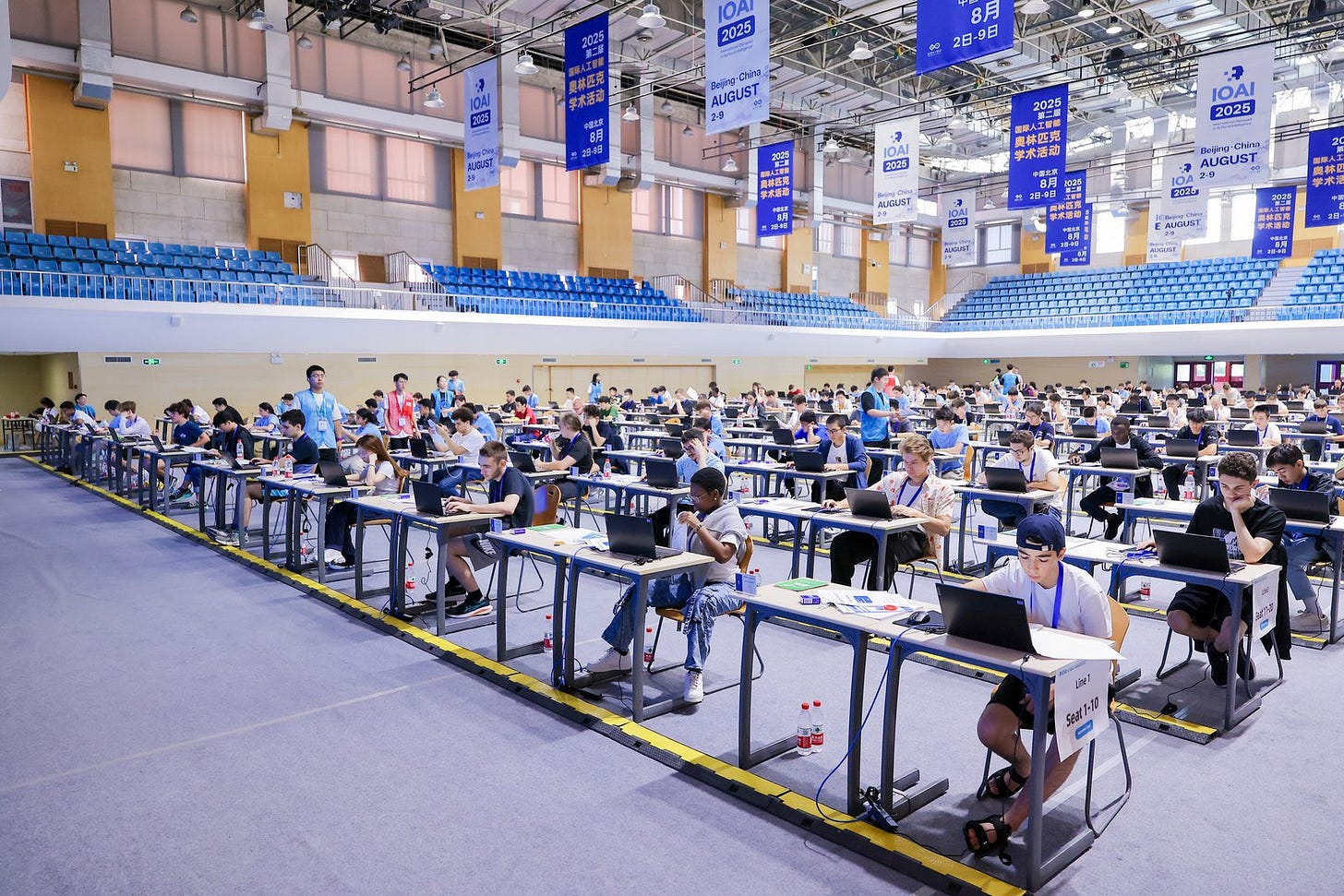Talent won over teraflops at the 2025 International Olympiad in AI; data center investments are showing up in GDP data; the AI bubble is fuelled by ARR but doomed by churn; meet the AI hype house
Young grads are making hundreds of thousands with AI; Agents4Science is a scientific conference powered by AI; how AI startups can hire or retain staff in the talent war; inside DHL's AI upgrade
The International Olympiad in Artificial Intelligence (IOAI), held this August in Beijing, ended with a reality check: the world’s AI superpowers, China and the United States, could not win a single gold medal in the individual or team competitions. Instead, craft won over capital. A Polish team won first place trophy in the team challenge while contestants from Europe and Asia came home with gold medals in the individual competition.
I spoke to three of the winners from my home country of Romania: Tudor-Ștefan Mușat, who got a perfect score on one of the hardest problems in the contest and clinched one of the gold medals, his teammate, Tudor Morariu, who brought home silver, and Ștefan-Alexandru Asandei, a bronze medalist. Together, they were part of the two teams that won eight medals for Romania, a country with fewer GPUs than Beijing has high-rises.

IOAI is a global competition that began last year, modelled after other science olympiads such as the International Maths Olympiad (IMO) or International Physics Olympiad (IPhO) that I dabbled in at the regional level as a kid.
The AI Olympiad included two six-hour individual sessions (according to Musat, “it’s the longest format I have ever faced”), with submissions that could take up to 10 minutes to re-evaluate. That forced Musat, Morariu and Asandei to adopt the kind of scarce-resource thinking that Eastern Europeans excel at: get a sturdy baseline, then make surgical improvements instead of YOLOing moonshots.
“In such a broad and uncertain environment, not every idea or solution is guaranteed to work, and it’s easy to lose track of time. My approach was straightforward: I focused on securing as much of the baseline as possible, then built and refined my own code on top of that foundation. This way, I managed my time effectively while still leaving room for improvements and experimentation.” - Tudor Stefan-Musat
Asandei’s strategy was also very simple:
“I applied the same approach I used in past contests. I first read all the tasks and I started with the one I was most confident about. After that, I would change tasks based on inspiration for any new ideas or approaches.” - Ștefan-Alexandru Asandei
And the tasks weren’t “prompt-engineering theater.” They ranged from classifying antique paintings in high-dimensional space to building object-detecting robots, and even counting chickens from aerial imagery.
On the paintings problem, Mușat did what top practitioners do in the real world: he treated unlabeled structure as signal. He projected a 5-D dataset down with PCA, spotted a spiral with two distinct heads, hand-separated the classes, then tightened the decision with t-SNE, which got him a perfect score, better than anyone else on the board.
Morariu’s edge was similarly un-glamorous and very effective: with tiny datasets (hello, chickens), classic train-test splits are noise amplifiers. He let loss functions like MSE and cross-entropy guide iteration, and leaned on segmentation tricks he’d seen work before. According to him, “experience beats novelty.”
Asandei’s favorite task was Pixel Parsimony, where he had to find the optimal crop box in an image to compress the most essential information about an image, like where the subject is. He tried various techniques and felt like creativity played an important role in his success.
Why did the AI giants whiff on gold? Partly because this is still a nascent high-school discipline; much of modern AI is graduate-level literature, and luck looms large when the environment is unfamiliar. Asandei believes the US doesn’t take Olympiads seriously at the local level while Chinese students struggle with independent learning outside the classroom:
“Since AI is such a new topic, students have to learn on their own a lot, from the required mathematics and coding, to machine learning and deep learning. I think China has a strong and centralized school system, and students are not used to learning topics on their own, however I’m sure this will change as they are already integrating AI into their curriculum. In the US, they lack a culture of Olympiads. In Romania, we are used to at least three to four phases for every competition: local, regional, national and team selection. This way students learn hard work and study independently.” - Ștefan-Alexandru Asandei
The IOAI rulebook also neutralized a common crutch: contestants had access to a token-limited GPT-4o inside a sandboxed Bohrium environment, with the broader internet blocked. Although Mușat found Bohrium unreliable, prone to buggy code and repetition, sometimes choking on longer outputs, the net result was that there was a tax on prompt-dependence and a reward for reasoning (the human kind, not the AI model variety).
Romania sent two teams drawn from a national selection that starts with ~30 students and whittles to eight after a camp of multi-day contests. The culture is IOI/IMO-hard, and it shows. Mock problems tracked the real thing uncannily well this year, and the mantra Mușat would hand next year’s cohort is the most old school one in AI: read, code, test. Read papers. Implement ideas yourself. Measure relentlessly. It’s not very glamorous, but it’s repeatable.
For example, in the Chicken Counting challenge, Asandei’s solution was based on the discoveries he made while working on the at-home task. The task requires the development and training of a neural network to count the number of chickens in a photo:
“The data was nothing special, just the expected images. The essential observation however, was for the data extraction: the latent vectors representing image features. For this kind of image analysis, I decided to use a UNet network. For better feature engineering, I added attention modules. The training was done in a quick manner, as I got optimal results in under 20 epochs with cosine decay learning rate scheduling, gradients and logits clipping, and AdamW as the optimizer. The great flexibility of the network enabled the straightforward training, otherwise it could have taken much longer to tweak the right hyperparameters.” - Ștefan-Alexandru Asandei
In the team robotics challenge, Romania didn’t win the podium but still built a pathfinding stack that “just worked.” That matters in industry more than leaderboard glitter.
“The team challenge was very different from the rest of the competition. We had to program a robot that could identify objects, pick them up, avoid obstacles, walk up to tables, and place the objects down. Even though we didn’t finish among the top teams, it was a great experience to work on a real, physical robot. I think what we did especially well was our pathfinding algorithm, which reliably avoided all obstacles.” - Tudor Stefan-Musat
Even though winning eight medals doesn’t mean Bucharest will suddenly become the new Mountain View or Palo Alto, IOAI is a stress test of individual capability under constraints, not a proxy for national data center capex.
There’s a policy signal here for countries chasing “AI sovereignty” via budgets alone: talent pipelines beat trophy GPUs. Teach students to reason with limited tooling, force them to ship within time budgets, and normalize solving problems without off-the-shelf model kits—and you might get the next DeepSeek team. IOAI’s partial block on Hugging Face did exactly that, and Romania benefited.
Asandei’s advice for teams participating next year?
“Do not overthink. In hindsight, I overprepared for the tasks by learning techniques that were too complicated. The format of the contest is three tasks in six hours, which leaves less than two hours per task, excluding evaluation time. This requires the solutions to be short enough to be able to write, test and debug in that time.” - Ștefan-Alexandru Asandei
I asked Mușat what he remembers most from the award ceremony and he said it was the tension of waiting through the silvers, and the relief when his name didn’t get called:
“The moment I’ll never forget is the award ceremony. It was incredibly tense and full of excitement because none of us knew the results until the very end. I remember waiting eagerly, with my heart racing, as they announced the silver medalists. When my name wasn’t called, I felt this huge wave of relief — I knew I had secured a gold medal […] which was such a proud and unforgettable moment for me.” - Tudor Stefan-Musat
When the internet is off and the clock is on, AI looks a lot less like a parameter arms race and a lot more like craft under pressure. Romania’s eight medals give me hope that the scarcest resource in AI isn’t Nvidia GPUs, it’s still talent.
Mușat is heading to university, eyeing startups and real-world applications of AI. When I asked Morariu if he remembered any notable bugs in the coding environment, he reported, deadpan, there were no mosquitoes on campus (according to him, “actually, it was a feature, not a bug!”). Asandei wants to continue learning more about AI and maths, and is considering a career as a researcher in this field: “I believe AI can tell us so much about how brains work, how to understand and process our world from a mathematical point of view.” Also, they all agreed the Peking duck and Wonton soup were good. (Fun fact: Romanians love soup.)
My last question was about a common myth in AI that they’d want to dispel for anyone reading this newsletter, to which Morariu gave a very short answer: ChatGPT does not actually “think.” Sam Altman and Dario Amodei, please take notice — the kids are onto you.
And now, here are the week’s news:
❤️Computer loves
Our top news picks for the week - your essential reading from the world of AI
WSJ: These AI-Skilled 20-Somethings Are Making Hundreds of Thousands a Year
The New York Times: The A.I. Spending Frenzy Is Propping Up the Real Economy, Too
MIT Technology Review: Meet the researcher hosting a scientific conference by and for AI
Business Insider: Meta CEO Mark Zuckerberg is trying to poach your best employees. Here's how to stop them from leaving.
Sifted: The AI bubble: fuelled by an ARR obsession, undone by churn?
The New York Times: 8 Women, 4 Bedrooms and 1 Cause: Breaking A.I.’s Glass Ceiling
FT: Inside DHL’s AI upgrade: ‘Love it or hate it, you have to work with it’
WSJ: Silicon Valley Launches Pro-AI PACs to Defend Industry in Midterm Elections
TechCrunch: How chatbot design choices are fueling AI delusions
Bloomberg: AI Is Replacing Online Moderators, But It's Bad at the Job
Keep reading with a 7-day free trial
Subscribe to Computerspeak by Alexandru Voica to keep reading this post and get 7 days of free access to the full post archives.





